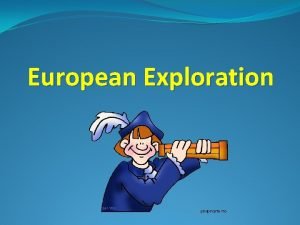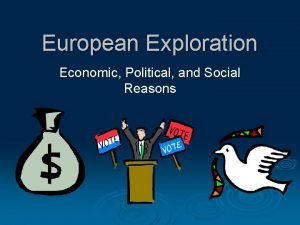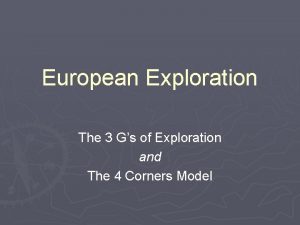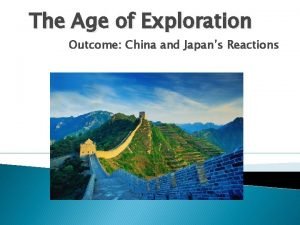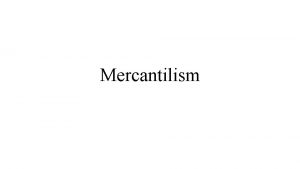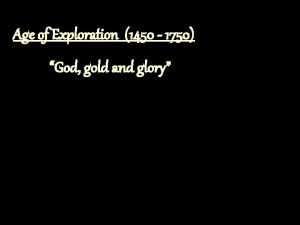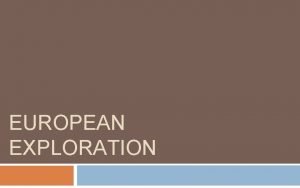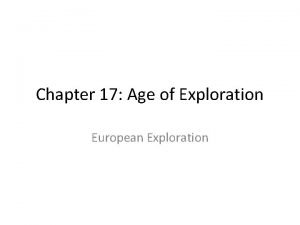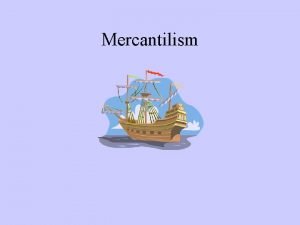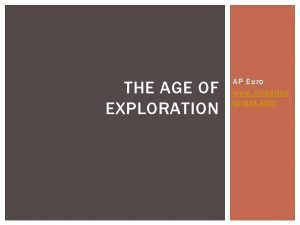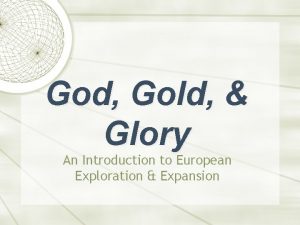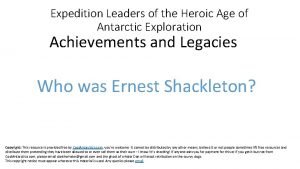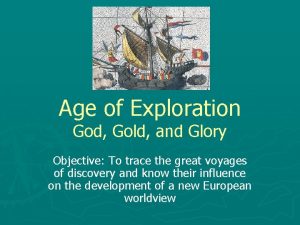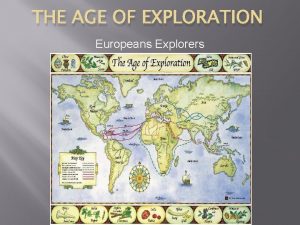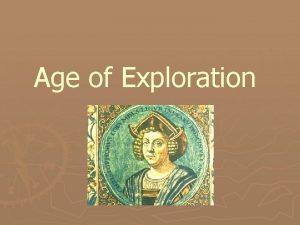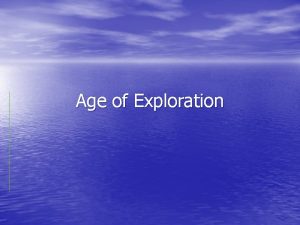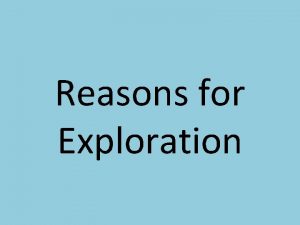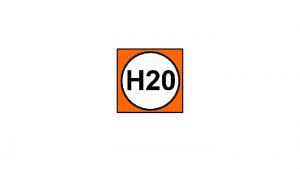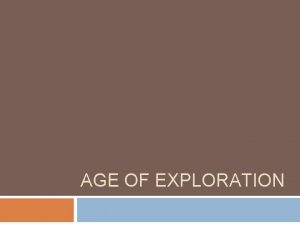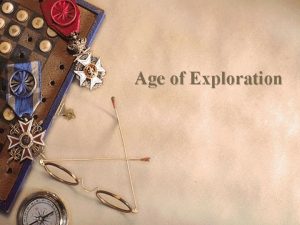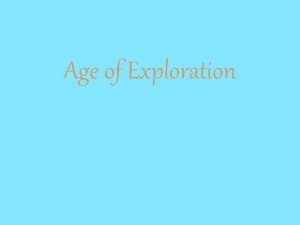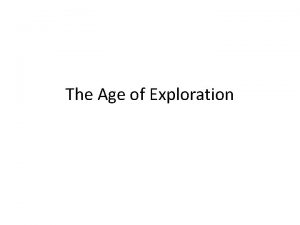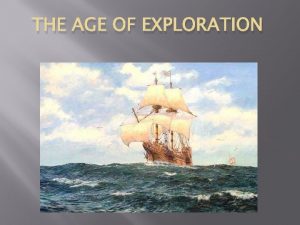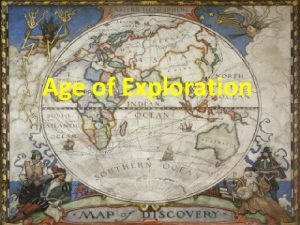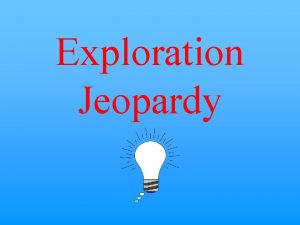AGE OF EXPLORATION THE EXPLORERS REASONS FOR EXPLORATION



















- Slides: 19

AGE OF EXPLORATION THE EXPLORERS

REASONS FOR EXPLORATION • The fall of Constantinople in 1453 led to a search for new trade routes by the Europeans. This led to the Age of Exploration. • Developments in technology helped make exploration possible. • The caravel was a new type of ship-studier, new sails, more sails • The astrolabe could calculate latitude made sailing easier both day and night

• Europeans were looking for places to gain wealth through the trade of spices and other goods. • Europeans wanted to spread Christianity to parts of the globe. • 3 Gs: God , Gold, Glory • The first Europeans to arrive in the “New World” were the Vikings under the leadership of Leif Erikson in 1000.


THE PORTUGUESE LEAD THE • WAY The Portuguese began to explore the western coast of Africa under the leadership of Prince Henry “The Navigator”. • Prince Henry founded a sailing school to teach others about sailing. • By 1460 the Portuguese had established trading post along the west African coast • In 1488 Bartolomeu Dias and his crew became the first Europeans to travel around the southern tip of Africa. • In 1497 Vasco da Gama reached India and found spices such as pepper, cinnamon, rare silks, and precious gems. • This voyage gave the Portuguese a direct sea route to India


SPAIN MAKES CLAIMS • Spain had grown envious of the amount of wealth Portugal was gaining through its route to India. • In 1492 an Italian named Christopher Columbus convinced the Spanish Queen Isabella I that he could find a quicker route to Asia. • In October he reached the West Indies (somewhere in the present day Bahamas). He thought he had reached India so he called the natives indians. • Columbus made 3 more voyages to the new world. His exploration opened the new world to Spanish conquest.


CONFLICT BETWEEN SPAIN AND PORTUGAL • By 1493 Spain and Portugal were rivals competing for the dominance of the world. • In 1493 Pope Alexander VI decided to divide the world in two in order to make peace between the two nations. • The Pope suggested an imaginary line drawn through the Atlantic. This is known as the Line of Demarcation. • All the lands to west of the line belonged to Spain and the lands to the east to Portugal. • In 1494 both Spain and Portugal signed the Treaty of Tordesilla.


CHALLENGES TO SPAIN AND PORTUGAL • Portugal dominated European trade with Asia for more than a century. • By 1600 other nations began to make claims to Asia. • The Dutch (Netherlands) became a leading sea power with 20, 000 ships. • The Dutch and English both established companies to direct trade in Asia. The Dutch East India Company was more powerful and soon became the dominate force in Asia. • However all the European powers were limited to the coasts.

SHIFTING FOCUS • By the 1600 s European powers were not only focused on Asian but the Americas too. • The Spanish conquistador Hernando Crotes had defeated the Aztecs in 1521 while searching for gold. • The conquistador Francisco Pizarro defeated the Inca empire after capturing the ruler Atahualpa in 1533. • The Portuguese settled Brazil and the Spanish pushed north into what is now the United States.


OTHER EXPLORERS • 1510 – 13 Vasco de Gama, Panama and the Pacific Ocean • 1511 Juan Ponce de Leon reaches Florida searching for the fountain of youth • 1519 Ferdinand Magellan, sailed (circumnavigated) around the world. He dies on the voyage. • 1524 Giovanni da Verrazzano, New York Harbor • 1534 Jacques Cartier, Lake Champlain Montreal • 1540 Francisco de Coronado, Southwestern U. S.




• 1540 s Hernando de Soto explores the Southeastern U. S. He dies on the journey. • 1600 Henry Hudson, New York area and Hudson River • 1609 Pedro de Peralta, Santa Fe • 1608 Samuel de Champlain, Quebec New France • 1673 Marquette and Joliet, Great Lakes, Upper Mississippi River • 1683 La Salle, Lower Mississippi River

 Iron age dates
Iron age dates Iron age bronze age stone age timeline
Iron age bronze age stone age timeline Three g's of european exploration
Three g's of european exploration European exploration economic reasons
European exploration economic reasons What were the 3 gs of exploration
What were the 3 gs of exploration What are the 5 reasons for exploration
What are the 5 reasons for exploration What was the outcome of china's age of exploration?
What was the outcome of china's age of exploration? Mercantilism
Mercantilism Age of exploration videos
Age of exploration videos Age of exploration gold
Age of exploration gold “god, glory, gold”
“god, glory, gold” Age of exploration motives
Age of exploration motives Mercantilism during the age of exploration
Mercantilism during the age of exploration Mercantilism
Mercantilism Pizarro map
Pizarro map Gold god glory
Gold god glory Heroic age of antarctic exploration
Heroic age of antarctic exploration Saq-14
Saq-14 Age of exploration vocab
Age of exploration vocab Age of exploration god
Age of exploration god


